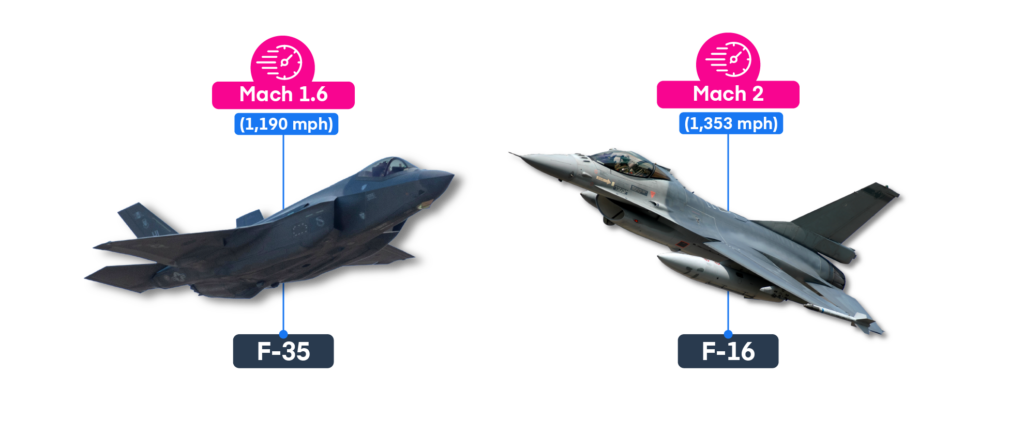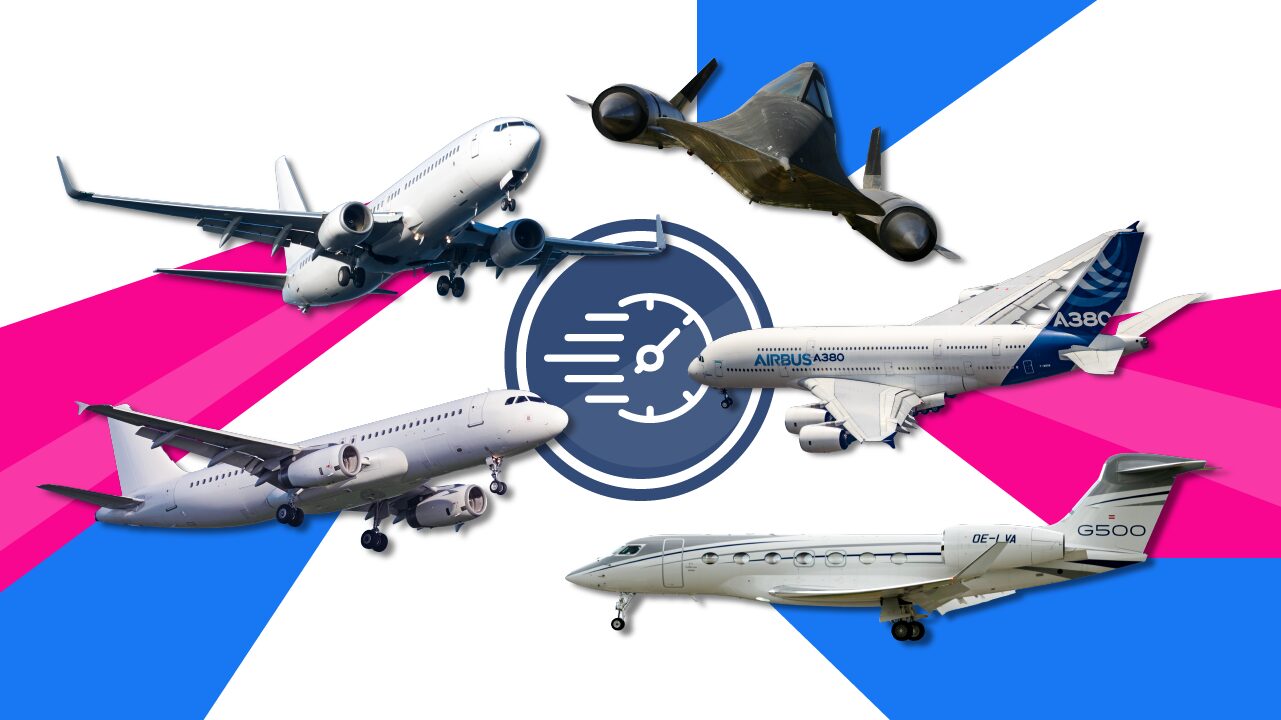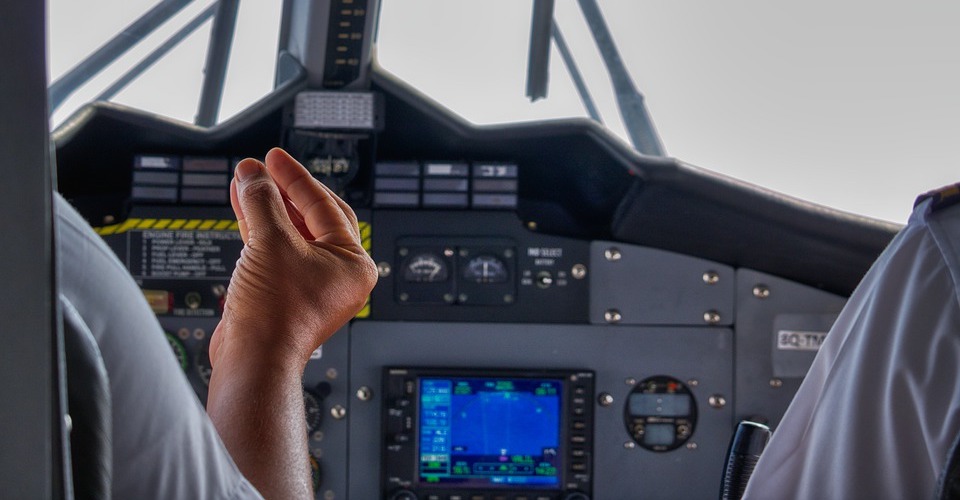What’s that above you? Is it a bird? Is it a plane? Well, if it is a jet plane, you might be surprised to know that it’s cruising at close to the speed of sound!
Aircraft seem to drift lazily across the sky, but actually, they’re making their way deceptively fast. Since they’re flying so high, it’s hard to judge how fast they’re really flying.
In this article, we’ll show you how fast different aircraft types fly and offer a glimpse of what you can expect in the future.
Key Takeaways
- Aircraft use airspeed instead of ground speed.
- The Mach scale is useful when flying close to the speed of sound.
- Passenger aircraft fly close to Mach 1 but can’t get too close without causing damage – unless they’re designed for it.
- Military jets have supersonic capabilities for advantages in combat.
- General Aviation aircraft fly low and slow.
- Supersonic aircraft could be back in service soon, with hypersonic aircraft to follow eventually.
How Fast Do Airliners Fly?
An airliner’s speed is a balance between time taken and rate of fuel consumption. You can fly fast to save time, but you’ll burn a lot of fuel doing it. Manufacturers decide the optimum cruise speed based on the type of routes they intend the aircraft to fly.
The two most popular narrow-body commercial jets are the Airbus A320 and Boeing 737. Both fly at around Mach 0.78 (587 mph).

Larger airliners, such as the Boeing 787 and the Airbus A380, are designed for long-haul routes. Both cruise at 0.85 Mach (669 mph). These long-haul jets cruise faster than short-range aircraft as they can save much more time on long flights than short hops.

Private jets fly even faster. Their operators can afford to burn more fuel to fly faster as they prioritize saving time for their passengers. Newer model private jets also fly higher than commercial airliners, with altitudes ranging from 45,000 feet to 51,000 feet. The thin air allows aircraft like Gulfstream’s GV series and Bombardier’s Global Express jets to cruise at Mach 0.90 (715 mph).

By far, the fastest commercial aircraft of all time was the Concorde, introduced in 1976. Specifically designed for supersonic flight, it cruised at Mach 2.04 (1,559 mph) and could cross the Atlantic in less than three hours. For context, conventional jet airliners need at least six hours for the same journey.

Concorde’s high speeds inevitably led to its high operating costs, the main reason it ceased flying in 2003.
How Fast Do Military Jets Fly?
Military jet aircraft have different capabilities depending on their intended mission.
Transport, tanker, and military cargo aircraft have similar roles to commercial jet aircraft. That’s why they generally have similar performance.
For example, cargo airplanes like the Boeing C-17 Globemaster and the Lockheed C-5 Galaxy cruise around Mach 0.77 (520 mph). You’ll note that these are slightly slower than commercial jets. Their design focuses on payload capacity and short-field capabilities over outright speed.

Fighter jets are the fastest type of military jet as speed offers huge tactical and strategic advantages in combat. That’s why all modern fighter jets are capable of supersonic flight.
Multi-role fighters like the F-35s and F/A-18Es can fly at Mach 1.6 (1,190 mph). Interceptors like the F-16 prioritize high speed over stealth or carrier operations, so they fly faster at up to Mach 2 (1,353 mph).

Interestingly, these fighters can only attain their top speeds for short periods with the help of afterburners. They fly subsonic in regular cruise flight at around Mach 0.9 (621 mph).
Some military jets have the ability to supercruise. They can fly supersonic for an extended time without engaging afterburners. For example, the F-22 Raptor supercruises at Mach 1.82 (1,220 mph) and the Eurofighter Typhoon at Mach 1.5 (1,035 mph). If the F-22 uses its afterburners, it can reach Mach 2.25 (1,500 mph).
The fastest jet aircraft of all time was the Lockheed SR-71 Blackbird. A long-range, high-altitude aircraft, it flew reconnaissance missions during the Cold War. The Blackbird could fly up to Mach 3.32 (2,193 mph), allowing it to outrun any interceptor aircraft or surface-to-air missiles.

It was so capable that it flew unchallenged for over 24 years. Only the development of satellite-based reconnaissance coverage led to its eventual retirement in the 90s.
How Fast Do Small Airplanes Fly?
On the other end of the airspeed scale lie small general aviation aircraft. They fly at speeds below 300 knots (Mach 0.45) and fly under 25,000 feet. The Mach scale is unnecessary at these low speeds and altitudes, and pilots use IAS instead.
General Aviation airplanes include four-seaters such as the Cessna 172, Piper Cherokee, and Diamond DA40. They cruise at around 125 knots (143 mph) and have maximum speeds of about 160 knots (184 mph). Newer single-engined aircraft like the Cirrus SR22 and Columbia 350 can reach 200 knots (230 mph).

These small aircraft are significantly slower than the jets described earlier. That’s because they use piston engines with far less power than jet engines. Piston engines also don’t work very well in the thin air at higher altitudes.
To improve performance above 15,000 feet, aircraft manufacturers add a turbocharger to compress the incoming air. The turbo variants of several aircraft get a healthy boost in their top speed and cruise altitudes.
For example, Mooney’s M20 Bravo Turbo flies about 35 knots (41 mph) faster than the non-turbo variant. It can also cruise up to 25,000 feet compared to 18,500 feet for the original model.
In general, modern general aviation aircraft aren’t much faster than their predecessors. The focus has been on improving comfort, safety, and fuel efficiency. Speed isn’t really a priority for aircraft in this segment.
How Fast Will Airplanes Fly in the Future?
Given the problems associated with approaching Mach 1, conventional airliners aren’t likely to ever fly much faster than they do today. Entirely different aircraft would need to be introduced to shrink the world again.
Even today, multiple supersonic aircraft are under development, with first flights expected as early as 2024. NASA and Lockheed Martin’s X-59 and Boom’s Overture are the leading contenders for supersonic jets to make a comeback.
But why haven’t we seen any supersonic passenger jets after the Concorde?
Supersonic aircraft development wound down in the years after the Concorde went out of service. High operating costs weren’t the only issue for supersonic jets. The other major problem Concorde faced was the deafening noise it made as it flew past Mach 1.
When an aircraft flies faster than sound, it creates shockwaves that combine to make a sharp, thunder-like noise. This noise is called a sonic boom, and it created significant public opposition in populated areas that Concorde overflew.
In response, the FAA and other aviation authorities banned civil aircraft from supersonic flight over land. This heavily restricted where Concorde could fly and discouraged future supersonic development.
The X-59 is part of NASA’s QueSST mission to significantly reduce the sonic boom to a low thump sound. The aircraft’s sleek shape redirects sonic booms upward instead of toward the ground while cruising at Mach 1.4 (937 mph).
With its first flight planned in 2024, NASA hopes the new technology convinces regulators to lift the supersonic ban over land.
The Overture, offered by startup Boom Technology, is an 80-passenger airliner designed to fly at Mach 1.7 (1,100 mph). The aircraft is currently under active development and should be in the air by 2026.
There have been multiple failed attempts at developing a successor to Concorde over the years, such as the Aerion AS2 and Boeing’s Sonic Cruiser. The Boom Overture seems promising, considering it has orders from United and American Airlines. Its order book currently stands at 130, making its future look bright.
There’s a category of aircraft that’s even faster than supersonic. They’re called hypersonic jets, which means they can fly at more than five times the speed of sound.
The North American X-15 holds the world record for the highest speed in a crewed, powered aircraft, reaching Mach 6.7 (4,520 mph) way back in 1967. Most hypersonic development since then has been for missiles and rockets.
In June 2023, however, Boeing announced a concept hypersonic passenger aircraft that could take you across the Atlantic in just two hours. It will use a combination of jet engines and ramjet engines to cruise at a blistering Mach 5. Expect to fly on it sometime in the next 20 to 30 years!
Conclusion
Still curious about the different types of speeds we talked about?
Here’s our guide on the six different types of airspeeds.



